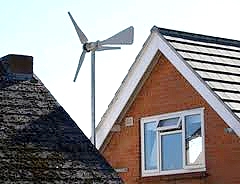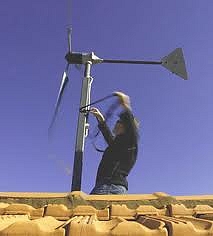Wind Energy - Pros and Cons for Your Home and Wind-Solar Hybrid Benefits
Solar cell arrays are becoming very popular in Australia primarily because of the financial incentives of feed-in tariffs in urban areas and for remote rural properties. The huge commercial Wind Farms are also becoming very prominent in rural areas.
But despite the steep rise in energy costs residential wind-energy systems are relatively rare.
Australia is an ideal country for solar energy because of its abounding sunshine and cloud free days, but many areas, particularly along the coast are also ideal for wind energy because of the prevailing sea breezes which blow from mid-morning until late in the evening. The wind is much more reliable than the sun in many respects as its dark for 8-12 hours per day and its often cloudy along the coast.
Likewise the windy times of the day is much more closely aligned to the time of peak power needs and consumption - in the early evening for the first few hours of darkness.
When its cloudy its usually windy and so a hybrid solar-wind system may have merit.
However, in the communities along the coast where I have a holiday house, wind-energy turbines are very rare and virtually non-existent. Why?

Pros and Cons of Wind Energy





Below is an overview of the pros and cons of your own domestic wind energy generation system tied to the grid for units generally less than about 20 kW.
Pros of Wind Energy
► Wind is renewable, low cost and freely available. You or your businesses may even be eligible to receive tax credits or other benefits.
► There is no waste or pollution from the system and no environmental problems apart from noise which is minimal for small domestic systems
► Depending on the type wind turbine system it can be low maintenance and can last 20-30 years. In general, the more complex systems with more moving parts require more repairs and maintenance. The vertical wind power designs are very simple and have low maintenance, but they may have lower efficiency
► You may be entitled to feed-in credits for the excess power you generate and feed into the grid.
► There may be numerous wind energy financial incentives available
There are numerous reputable suppliers of the equipment that have proven track records and contacts for satisfied customers.
► The land within the vicinity of the unit can be used for a variety of other purposes.
► You need to check your local data but in many localities wind is the cheapest source of renewable energy, and is generally cheaper than solar electric (photovoltaic) systems of similar capacity. Depending on the wind-power system and electricity rates, your investment might break even in 10-20 years.
Cons of Wind Energy
► Wind is highly variable and are affected by numerous factors, including location, weather and season (and perhaps climate change). You need to do your homework as not all places are appropriate for wind energy. The power output will vary seasonally with weather patterns.
► The wind turbine system requires a major upfront which can increase substantially if you want a feed-in system, rather than a self-sustaining system for your own use.
► It is hard to fully evaluate the predicted wind system due to variability of turbine designs and outputs and the effects of conditions including sheltering affects on the wind actually hitting the blades to generate the power.
► Maintenance is required and some models require a lot of maintenance.
► Living with any renewable energy system requires a major change of lifestyle especially if the system provides all your power and you aren't connected to the grid. Checks for damage and checks will be required before major storm events.
► Local zoning laws and regulations may make it hard to install wind-power units in some localities, particularly in urban areas. Some neighbours may raise objections to the sight or sound of a swishing turbine, which will have to be dealt with and accommodated.
► While harm to birds is possible, research studies have shown that it is minimal and equivalent to the other hazards faced by birds such as collisions with windows and cats.
► Depending on location, it may be hard to find competent and capable technicians or service workers for repairing or maintaining your system. Travel costs can add to the costs.
Solar and Wind Hybrid Systems
A hybrid renewable energy system uses two or perhaps more ways of generating power. The most common one is a wind - solar hybrid.
The major advantage of wind - solar hybrid system is obvious - when two power production systems are used the system is more reliable and may not be all that more expensive because of this greater reliability.
Also smaller storage batteries may be required as there is less dependence on a single power production method.
Often, when its cloudy or at night, there is plenty of wind and when its calm there may be plenty of sunshine.
A hybrid system copes better with the need for repairs can maintenance - when one system is down you can rely on the other one.
Hybrid systems are certainly worth considering when there is a lot of seasonal variation in wind and sunshine availability.